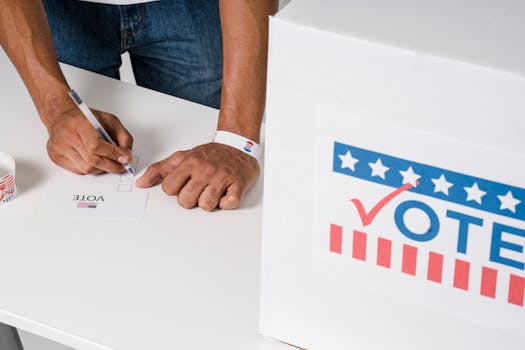Indice
- Introduction: The Foundations of American Democracy
- Voter Registration: Ensuring Citizen Participation
- Primary Elections: Choosing Party Nominees
- The Electoral College: A Unique System for Presidential Elections
- Voting Methods: From Paper Ballots to Electronic Systems
- Campaign Finance: The Role of Money in Elections
- Media Influence: Shaping Public Opinion and Election Outcomes
- Election Day: Processes and Procedures
- Vote Counting and Certification: Ensuring Accuracy and Transparency
- Swing States: Their Impact on Presidential Elections
- Third Parties and Independent Candidates: Challenges and Opportunities
- Election Security: Protecting the Integrity of the Vote
- Conclusion: The Future of U.S. Elections
Introduction: The Foundations of American Democracy

The Principles of Democracy
American democracy is built on foundational principles such as popular sovereignty, individual rights, and the rule of law. Popular sovereignty emphasizes that government derives its power from the consent of the governed, illustrated through regular, free, and fair elections. Individual rights, protected by the Constitution and Bill of Rights, ensure that citizens have freedoms such as speech, assembly, and religion. The rule of law signifies that laws apply equally to all individuals, including government officials, which is essential in maintaining justice and accountability.
The Constitutional Framework
The U.S. Constitution, ratified in 1788, lays the groundwork for American governance and electoral processes. It established a federal system where power is divided between national and state governments. The Constitution outlines the election processes for Congress, including the House of Representatives and the Senate, emphasizing the importance of representative democracy. Amendments, particularly the 15th, 19th, and 26th, expanded voting rights to ensure inclusive participation across races, genders, and ages.
The Role of Political Parties
Political parties play a crucial role in American elections, serving as a bridge between the electorate and government. They organize campaigns, mobilize voters, and articulate policy positions. The two dominant parties, the Democrats and Republicans, reflect a diverse range of ideologies and interests. While primaries and caucuses determine each party’s nominee, general elections are crucial for citizens to express their preferences and influence governmental policies, reinforcing the democratic principle of collective decision-making.
Voter Registration: Ensuring Citizen Participation

The Importance of Voter Registration
Voter registration is a crucial step in the election process, enabling citizens to participate in democracy. It serves as the gateway for individuals to exercise their right to vote, ensuring that they are counted in the electoral process. Without proper registration, individuals may be unable to cast their votes, leading to disenfranchisement. Each state has specific requirements and processes for voter registration, reflecting the importance of local governance in facilitating democratic participation. Moreover, by maintaining accurate voter rolls, states can ensure the integrity of elections, minimizing the risk of fraud and confusion on election day.
How to Register to Vote
The process of registering to vote varies by state, but generally includes some common steps. Citizens can register online, by mail, or in person at designated locations, including local election offices and DMV offices. Most states require basic information such as name, address, date of birth, and driver’s license number or Social Security number. Deadlines for registration often vary, with some states allowing same-day registration while others may require weeks or months in advance. Many organizations also assist with voter registration drives, actively working to increase participation among underrepresented communities, ensuring that every voice is heard in the electoral process.
Challenges to Voter Registration
Despite its importance, voter registration faces various challenges that can hinder participation. Issues such as strict ID laws, purging of voter rolls, and limited access to registration sites disproportionately affect certain demographics. Moreover, misinformation regarding registration requirements or deadlines can further complicate the process for potential voters. Advocacy groups are actively working to address these challenges by promoting awareness and providing resources to support voter registration efforts. Ensuring equitable access to the registration process is vital for fostering a representative democracy that reflects the diverse views and interests of the population.
Primary Elections: Choosing Party Nominees

The Purpose of Primary Elections
Primary elections serve as a critical mechanism in the U.S. political system, enabling political parties to select their nominees for the general election. These elections can take various forms, including open, closed, or semi-closed primaries, depending on the rules set by each state. Open primaries allow all voters, regardless of party affiliation, to participate, while closed primaries restrict participation to registered party members. This process helps ensure that the candidates representing each party have garnered enough support from the party’s base, increasing the likelihood of a competitive general election.
There are two main types of primary elections: direct and indirect. Direct primaries involve voters casting ballots to choose their preferred candidates, while indirect primaries use delegates who select the nominee at a party convention. The direct primary system is more common, as it allows for a more democratic selection process. In recent years, primary elections have gained attention due to their impact on the political landscape, shaping candidate platforms and influencing issues that resonate with voters. The increasing visibility of debates and campaign events during primaries further emphasizes their significance in the electoral process.
The Impact of Primaries on General Elections
The outcomes of primary elections can have profound effects on general elections. A candidate who performs well in the primaries often gains momentum, attracting media attention, fundraising opportunities, and increased voter interest. Conversely, candidates who struggle in primaries may find it difficult to rally support for the general election. Moreover, the dynamics within party primaries can lead to the emergence of extreme candidates, as primary voters may be more ideologically motivated than the general electorate. This phenomenon raises concerns about the overall representativeness of general elections and the ability of candidates to appeal to a broader range of voters post-primary.
The Electoral College: A Unique System for Presidential Elections
The Structure of the Electoral College
The Electoral College is a unique mechanism established by the U.S. Constitution for electing the President and Vice President. It consists of 538 electors, with each state allocated a number of electors proportional to its congressional representation—this means each state gets as many electors as it has senators (always two) and representatives in the House. For instance, California, being the most populous state, has 55 electors, while smaller states such as Wyoming have three. The candidate who secures a majority of the electoral votes (at least 270) wins the presidency, a process that reflects the federal nature of the United States where both the states and the people play a role in national elections.
How the Electoral College Works
During the presidential election, citizens cast their votes for their preferred candidate on Election Day, but they are technically voting for a slate of electors pledged to that candidate. Most states employ a winner-takes-all approach, meaning the candidate receiving the majority of the popular vote in that state gets all its electoral votes. However, Maine and Nebraska use a proportional allocation method, where electoral votes can be split between candidates based on the popular vote outcome within the state. This system aims to balance the influence of populous states with less populous ones and maintain a connection between the national and state levels of government.
Controversies and Criticisms
While the Electoral College has been a cornerstone of the U.S. presidential election system for over two centuries, it has faced significant criticism. Detractors argue that it can distort the democratic principle of one person, one vote, as candidates tend to focus their campaigns on swing states—states where both parties have similar levels of support—while ignoring those with solid majorities. This could lead to scenarios where a candidate wins the presidency without winning the popular vote, as seen in the elections of 1824, 1876, 1888, 2000, and 2016. Calls for reform, including proposals for a direct popular vote or the National Popular Vote Interstate Compact, underscore the ongoing debate about the relevance and fairness of the Electoral College in modern America.
Voting Methods: From Paper Ballots to Electronic Systems

Traditional Voting Methods: Paper Ballots
Paper ballots have been the cornerstone of the voting process in the United States for centuries. Voters receive a physical ballot where they can mark their choice in privacy, ensuring confidentiality. These ballots are often collected in sealed boxes or drop-off locations and later counted either manually or through optical scan systems. While paper ballots are considered reliable and provide a tangible record of votes, they do require careful handling and storage to prevent fraud or errors. Additionally, the process of counting paper ballots can be time-consuming, potentially delaying election results, especially in close races.
The Rise of Electronic Voting
In response to the need for efficiency and accuracy, many jurisdictions have adopted electronic voting systems. These range from Direct Recording Electronic (DRE) systems, where votes are cast on touchscreens, to optical scan systems that read filled-in paper ballots using advanced scanning technology. Electronic voting aims to streamline the voting process, reduce counting errors, and improve accessibility for individuals with disabilities. However, concerns about cybersecurity, technical malfunctions, and the lack of a physical paper trail have led to calls for transparency and verification methods to ensure the integrity of electronic elections.
Mail-In Voting and Absentee Ballots
Mail-in voting and absentee ballots have gained significant traction, especially highlighted by the COVID-19 pandemic. Voters request ballots to be mailed to them, allowing for convenience and safety in participating in elections without visiting polling places. This method has expanded access to voting, enabling those who cannot physically attend due to health or logistical reasons to exercise their civic duty. However, challenges such as application deadlines, signature verification processes, and potential postal delays spark debates on ensuring that mail-in voting remains secure and reliable. As states continue to evolve their voting policies, the integration of various methods aims to balance accessibility with election integrity.
Campaign Finance: The Role of Money in Elections

The Significance of Campaign Finance
Campaign finance refers to the funds raised and spent to promote candidates, political parties, or policies during elections. Money plays a vital role in the electoral process as it enables candidates to communicate their messages, reach out to voters, and compete effectively. Comprehensive funding is crucial for expenses such as advertising, staffing, organizing events, and even fundraising efforts. With escalating campaign costs, especially in presidential races, the financial backing candidates receive is often a determining factor in their competitiveness and outreach capabilities, influencing voters’ perceptions and engagement.
Regulations and Laws Governing Campaign Finance
Campaign finance in the United States is regulated primarily by the Federal Election Commission (FEC), which enforces laws regarding the contribution limits and disclosure requirements. Key legislation, such as the Federal Election Campaign Act (FECA) and the Bipartisan Campaign Reform Act (BCRA), was established to promote transparency and curtail undue influence by limiting the amounts individuals and entities can contribute. Recent Supreme Court decisions, notably Citizens United v. FEC in 2010, have significantly altered the landscape by allowing unlimited spending from corporations and unions in support of candidates, leading to the rise of Super PACs (Political Action Committees) that can raise and spend unlimited funds independently of candidates.
The Impact of Money on Elections
The influx of money in elections has led to mounting concerns regarding the potential for corruption and the amplification of special-interest influence over policies and candidates. Wealthier candidates or those with substantial fundraising capabilities often dominate the narrative, making it challenging for grassroots campaigns to gain traction. This has spurred calls for reforms, including public financing of campaigns, to level the playing field and restore electoral integrity. Voters are increasingly aware of the implications of campaign finance, as it shapes political environments and can sway the focus toward issues prioritized by affluent donors rather than constituents’ needs, raising questions about democracy’s responsiveness to the general populace.
Media Influence: Shaping Public Opinion and Election Outcomes

The Role of Media in U.S. Elections
Media plays a crucial role in American elections by informing the public, shaping perceptions, and influencing voter behavior. Through various platforms, including television, radio, print, and the internet, media outlets provide coverage of candidates, policies, and election-related events. This dissemination of information is vital for voters, enabling them to make informed choices at the ballot box. However, media outlets can also shape narratives that highlight specific issues or candidates, often reflecting their own biases, which can skew public perception and significantly impact election outcomes.
Impact of Social Media on Elections
In recent years, social media has emerged as a powerful tool in shaping electoral dynamics. Platforms like Facebook, Twitter, and Instagram allow candidates to engage directly with voters, enabling them to communicate their messages and mobilize supporters effectively. Moreover, social media facilitates the rapid spread of information—both factual and misleading—creating opportunities for grassroots movements, as well as challenges related to misinformation and propaganda. The 2016 presidential election notably showcased how social media can amplify divisive rhetoric and influence voter turnout, prompting discussions about regulation and ethical standards in digital campaigning.
Challenges of Media Influence
Despite its critical role in elections, media influence poses several challenges. The rise of partisan news outlets has contributed to polarization, as voters may seek information that aligns with their beliefs rather than objective reporting. This can create echo chambers, diminishing dialogue and understanding between differing political perspectives. Additionally, concerns over misinformation—particularly from social media sources—have raised alarms about the integrity of electoral processes. Efforts to combat fake news and promote media literacy are essential to ensure that voters can discern credible information from misleading narratives, ultimately supporting a healthier democratic environment.
Election Day: Processes and Procedures

The Significance of Election Day
Election Day is a pivotal moment in American democracy when voters exercise their right to choose public officials and influence government policies. Held on the first Tuesday after the first Monday in November, this day is the culmination of a lengthy electoral process involving primaries, campaign activities, and voter registration. The significance of Election Day lies not only in the act of voting but also in the collective engagement of citizens, reflecting the democratic principle of popular sovereignty. As voters head to polling places across the country, they participate in shaping their government, illustrating the fundamental power of the electorate in a democratic society.
The Voting Process on Election Day
On Election Day, voters typically arrive at their assigned polling places to cast their ballots. Upon arrival, they must provide identification, if required by their state, and confirm their registration status. Voters then receive their ballots, which may be in paper or electronic form, and proceed to mark their choice private from public view. This process is designed to ensure the confidentiality and integrity of the vote. After marking the ballot, voters submit it—either by physically placing it in a ballot box or using electronic voting machines, which electronically log their votes. Some states even offer opportunities for same-day registration, enabling last-minute participants to engage in the electoral process.
Closing Polls and Counting Votes
Polling places close at designated times in each state, although these times can vary. Once the polls close, election officials secure the ballots and begin the counting process. Many states employ optical scan systems to tally votes, while others might rely on manual counting for paper ballots in close races. Election night results are often disseminated quickly, but complete, certified results may take days or even weeks to finalize, particularly in states where absentee ballots or mail-in votes are prevalent. Election officials work diligently to ensure accuracy, uphold election integrity, and address any discrepancies that might arise, reinforcing the importance of transparency throughout the process.
Vote Counting and Certification: Ensuring Accuracy and Transparency

The Vote Counting Process
Vote counting is a crucial step in the electoral process, occurring after polls close on Election Day. The process begins with the secure collection of ballots, which can include paper ballots and electronic votes, depending on the voting methods used in each state. Election officials employ multiple methods for counting, such as optical scan technology for paper ballots and electronic vote tabulators for direct recording electronic (DRE) systems. Each state has set procedures and timelines for counting votes, ensuring that the process is thorough and meets legal requirements. Transparency is paramount; many jurisdictions allow observers from political parties and independent organizations to monitor the counting process, ensuring accountability and fostering public trust in the outcome.
Certification of Election Results
Once votes are counted, the next step is the certification of election results. Certification is the official confirmation that the results are accurate and have been legally verified according to state laws. Each state has its own timeline for certification, usually requiring a final canvass of the results that allows for scrutiny and, if necessary, recounts. Certification often involves checks for potential discrepancies, such as reviewing random samples of ballots or auditing electronic voting machines. This process is essential for ensuring that every vote is counted accurately and that the final results reflect the will of the electorate. Only after certification can candidates be officially declared as winners and assume their duly elected positions.
Challenges in Vote Counting and Certification
Vote counting and certification are not without their challenges. Issues such as equipment malfunctions, mismatched signatures on mail-in ballots, or discrepancies in ballot counts can lead to delays and disputes over election outcomes. Moreover, high voter turnout or close races can strain resources and necessitate recounts, which can further extend the certification timeline. Legal challenges may also arise, particularly in contentious elections, complicating the certification process. To mitigate these challenges, many states have implemented rigorous training for election officials and established clear guidelines for managing the counting and certification processes. Advocacy for improved technology and standardized procedures continues to grow, aimed at enhancing the accuracy and transparency of U.S. elections.
Swing States: Their Impact on Presidential Elections

Understanding Swing States
Swing states, also known as battleground states, are those states where both major political parties have similar levels of support among voters. This competitive nature means that electoral outcomes in these states can vary significantly from one election to another, making them critical to the overall results of presidential elections. Unlike solidly Democratic or Republican states, swing states can tip the balance in favor of either candidate, influencing the electoral college count. Key swing states often include Florida, Pennsylvania, Ohio, and Wisconsin, characterized by their diverse demographics and shifting political landscapes. Candidates focus heavily on these states during their campaigns, aiming to secure crucial electoral votes and rally support from undecided voters.
The Role of Swing States in Electoral Strategy
Candidates recognize the strategic importance of swing states as they shape their campaign approaches and resource allocation. During election cycles, candidates often tailor their messages and policies to resonate with the specific issues and concerns of voters in these states. Campaign events, advertisements, and outreach efforts are heavily concentrated in swing states to maximize voter engagement. Additionally, political parties deploy significant financial resources and mobilization efforts in these areas to boost voter turnout. Because swing states can determine the election’s outcome, they often receive a disproportionate amount of media attention and campaigning compared to other regions, underscoring their crucial role in the democratic process.
Impact of Swing States on National Political Trends
The dynamics of swing states can also reflect broader shifts in national political trends. Changes in voter turnout, demographics, and party identification in these states can signal evolving political attitudes and priorities across the country. For instance, a candidate’s success in a swing state may indicate changing sentiments on issues like healthcare, immigration, or economic policy, leading to shifts in parties’ platforms in subsequent elections. The focus on swing states can also influence the national conversation, as issues prioritized by these voters force candidates to address the concerns of constituencies that may have historically been overlooked. As a result, swing states serve as a bellwether for both immediate electoral outcomes and longer-term political trends in the United States.
Third Parties and Independent Candidates: Challenges and Opportunities

The Role of Third Parties
Third parties in the United States, while often overshadowed by the dominant Democratic and Republican parties, play a crucial role in enriching political discourse and representing diverse viewpoints. These parties, such as the Green Party, Libertarian Party, and others, often emerge to address specific issues or represent constituencies that feel overlooked by the major parties. Third-party candidates can influence election outcomes by drawing votes away from major party candidates, particularly in tight races, forcing the larger parties to acknowledge and address new ideas or policies. However, due to the first-past-the-post electoral system, these parties frequently struggle to gain traction in national elections.
Challenges Faced by Third Parties
Third parties encounter numerous challenges that hinder their success in U.S. elections. One significant obstacle is access to funding and resources. Major parties benefit from established donor networks and extensive fundraising capabilities, while third parties often rely on grassroots donations and volunteer efforts. Additionally, ballot access laws in many states present a formidable barrier, as third-party candidates must secure a varying number of signatures and fulfill specific requirements to appear on the ballot. Media coverage also tends to favor major party candidates, leading to limited visibility for third-party candidates and their platforms, further obstructing their election efforts.
Opportunities for Independent Candidates
Independent candidates, who run without party affiliation, also face unique challenges and opportunities. While they may experience similar hurdles regarding funding and media attention as third parties, they often benefit from increased appeal to voters disillusioned with mainstream politics. This appeal allows them to tap into a diverse range of voter concerns, presenting themselves as viable alternatives to polarized party politics. Moreover, the rise of social media has provided independents with a platform to communicate directly with voters, enabling them to bypass traditional media gatekeepers. Successful independent campaigns may inspire future candidates to pursue non-traditional paths, potentially reshaping the political landscape and encouraging greater electoral participation among disenchanted voters.
Election Security: Protecting the Integrity of the Vote

The Importance of Election Security
Election security is critical for maintaining public trust in the democratic process. Ensuring that elections are free from interference, whether from foreign entities or domestic threats, is vital for upholding the integrity of the vote. Election security encompasses a range of measures, including securing voting systems, protecting voter data, and implementing physical safeguards at polling locations. With increasing incidents of cyberattacks and misinformation campaigns, the emphasis on robust election security measures has expanded, drawing attention from both government agencies and independent watchdog organizations. Voter confidence hinges on the belief that their voices will be accurately represented, making election security a cornerstone of functioning democracy.
Technological Advances and Vulnerabilities
Modern elections increasingly rely on technology, including electronic voting machines and online voter registration systems. While these innovations can enhance accessibility and efficiency, they also introduce vulnerabilities that must be addressed. Cybersecurity has become a major focus, with many states investing in protective measures to guard against hacking attempts and system failures. This includes regular security audits, updates to software, and the use of paper trails for electronic votes to allow for audits and recounts. However, ensuring that all voting technology is secure and resistant to potential breaches remains an ongoing challenge that states and election officials must continuously navigate.
Federal and State Initiatives for Election Security
In response to growing concerns about election security, both federal and state governments have implemented various initiatives. The U.S. Department of Homeland Security has designated election infrastructure as critical infrastructure, providing resources for states to enhance their security protocols. Funding mechanisms, such as the Help America Vote Act, have enabled states to upgrade outdated voting equipment and implement more secure practices. Additionally, the establishment of the Cybersecurity and Infrastructure Security Agency (CISA) has further assisted states in bolstering their defenses against cyber threats. Collaboration between state and federal authorities, along with private sector experts, continues to evolve as a necessary approach to addressing the complexities of election security in the digital age.
Conclusion: The Future of U.S. Elections
Emerging Trends in Electoral Participation
The future of U.S. elections is likely to see continued evolution in the ways citizens engage with the democratic process. Trends such as increasing voter participation, particularly among younger generations and marginalized communities, are reshaping the electoral landscape. Initiatives such as automatic voter registration and same-day registration are gaining momentum, aiming to simplify the voting process and enhance accessibility. Additionally, digital advocacy and social media campaigns are mobilizing voters more effectively than in past elections, reflecting a paradigm shift in how political engagement and civic responsibility are undertaken in a tech-driven era.
Technological Innovations and Their Implications
Advancements in technology are poised to greatly influence the future of U.S. elections. Innovations such as blockchain voting systems, online voter registration, and AI-assisted campaign strategies could contribute to more secure, efficient, and transparent processes. Electing officials and agencies are exploring ways to improve election security and mitigate risks associated with electronic voting. However, these developments also raise concerns surrounding privacy, data security, and the potential for cyber threats. The challenge will be to balance technological incorporation while safeguarding the integrity and reliability of the electoral process.
Addressing Polarization and Fostering Unity
With the current political climate marked by significant polarization, the future of U.S. elections will also involve efforts to foster unity and constructive dialogue among diverse voter groups. Initiatives aimed at reducing partisan divisions may play a crucial role in rebuilding trust in the electoral system and encouraging bipartisanship. Educational campaigns focused on media literacy and critical thinking can help combat misinformation while promoting informed voter choices. Ultimately, embracing inclusivity and understanding within the electorate will be vital for ensuring a healthy, vibrant democracy that reflects the collective will of the people.




